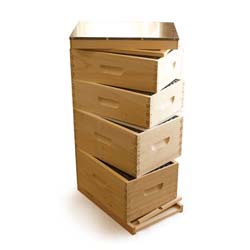There are a couple of methods of extracting honey from the comb. The first and most important step is removing the wax cappings that seal the honey inside each cell. Whether you use a hot knife, cold knife, uncapping roller, uncapping slicer, or any other tool, it is probably the most important step to the honey harvesting process. Without it, there is no way to access the honey (unless you plan on consuming the entire honeycomb – which is a valid option). The wax capping works incredibly well as a waterproof barrier between the honey and the air to keep honey safe – so removing the cappings first is key to extracting the honey.
It’s also worth noting that it’s very beneficial to have a designated place for processing honey. The space should be clean, dry and protected from insects and strong smells as honey is very hygroscopic and will absorb smells and moisture when exposed.
Using an extractor
An extractor is a cylindrical device used to pull (or extract) honey from honey frames. An extractor works like a centrifuge – by placing the frames in the barrel and spinning them quickly, it will remove any uncapped honey from honey frames. Extractors will have different sizes, allowing different amounts of frames to be held at a time. Extractors will usually hold even number of frames and contain some form of a basket to hold the frames. Make sure that your frames are balanced within the extractor.
Extractors can be motorized or mechanical with a hand crank. Either way, use the instruction manual to figure out how to use them. Most extractors work the same way – place the frames in the extractor, have it spin very fast, and it will drain the honey to the bottom of the extractor. Only use the maximum number of frames your extractor calls for – don’t try to shove in more frames than it can handle.
Crush and strain
This simpler method requires no special equipment. While it destroys the comb, it’s straightforward, inexpensive, and perfect for small-scale or first-time beekeepers.
With this method you will have to remove the honeycomb from the frames and foundation. Placing the honeycomb in some kind of mesh filter (whether a mesh bag, cheese cloth, or metal sieve – all work well!) and have something to catch the honey in (most people use food grade buckets). Whatever your tools, the method will still work the same: crush the honeycomb, letting the honey move through the strainer while keeping the comb separated.
Once you have crushed all your comb (and squeezed everything one last time just for good measure), your honey is good for bottling.
Cut-comb honey
Another option for harvesting honey is producing cut-comb honey. As the name suggests, this method involves cutting entire sections of honeycomb directly from the frame and then dividing them into smaller, neat pieces—usually squares or rectangles.
To prepare them for sale, allow any excess honey to drip off the edges before placing the comb into a clear “clamshell” food container. Cut-comb honey is enjoyed just as it is, with both the comb and honey eaten together.
Some beekeepers also use special frame inserts that guide the bees in creating uniform sections, making the process even easier. Keep in mind, though, that if you plan to harvest cut-comb honey, you’ll want to avoid using foundation or wires in your frames and instead allow the bees to draw out the comb naturally from scratch.
